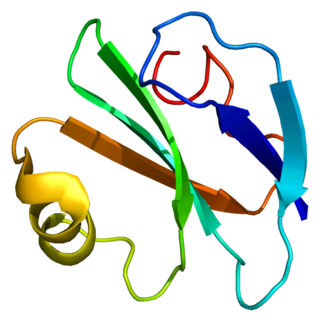
Choline acetyltransferase is a transferase enzyme responsible for the synthesis of the neurotransmitter acetylcholine. ChAT catalyzes the transfer of an acetyl group from the coenzyme acetyl-CoA to choline, yielding acetylcholine (ACh). ChAT is found in high concentration in cholinergic neurons, both in the central nervous system (CNS) and peripheral nervous system (PNS). As with most nerve terminal proteins, ChAT is produced in the body of the neuron and is transported to the nerve terminal, where its concentration is highest. Presence of ChAT in a nerve cell classifies this cell as a "cholinergic" neuron. In humans, the choline acetyltransferase enzyme is encoded by the CHAT gene.

Amyloid-beta precursor protein (APP) is an integral membrane protein expressed in many tissues and concentrated in the synapses of neurons. It functions as a cell surface receptor and has been implicated as a regulator of synapse formation, neural plasticity, antimicrobial activity, and iron export. It is coded for by the gene APP and regulated by substrate presentation. APP is best known as the precursor molecule whose proteolysis generates amyloid beta (Aβ), a polypeptide containing 37 to 49 amino acid residues, whose amyloid fibrillar form is the primary component of amyloid plaques found in the brains of Alzheimer's disease patients.

NLR family pyrin domain containing 3 (NLRP3), is a protein that in humans is encoded by the NLRP3 gene located on the long arm of chromosome 1.

Presenilins are a family of related multi-pass transmembrane proteins which constitute the catalytic subunits of the gamma-secretase intramembrane protease protein complex. They were first identified in screens for mutations causing early onset forms of familial Alzheimer's disease by Peter St George-Hyslop. Vertebrates have two presenilin genes, called PSEN1 that codes for presenilin 1 (PS-1) and PSEN2 that codes for presenilin 2 (PS-2). Both genes show conservation between species, with little difference between rat and human presenilins. The nematode worm C. elegans has two genes that resemble the presenilins and appear to be functionally similar, sel-12 and hop-1.

Neurogranin is a calmodulin-binding protein expressed primarily in the brain, particularly in dendritic spines, and participating in the protein kinase C signaling pathway. Neurogranin is the main postsynaptic protein regulating the availability of calmodulin, binding to it in the absence of calcium. Phosphorylation by protein kinase C lowers its binding ability. NRGN gene expression is controlled by thyroid hormones. Human neurogranin consists of 78 amino acids.

Neprilysin, also known as membrane metallo-endopeptidase (MME), neutral endopeptidase (NEP), cluster of differentiation 10 (CD10), and common acute lymphoblastic leukemia antigen (CALLA) is an enzyme that in humans is encoded by the MME gene. Neprilysin is a zinc-dependent metalloprotease that cleaves peptides at the amino side of hydrophobic residues and inactivates several peptide hormones including glucagon, enkephalins, substance P, neurotensin, oxytocin, and bradykinin. It also degrades the amyloid beta peptide whose abnormal folding and aggregation in neural tissue has been implicated as a cause of Alzheimer's disease. Synthesized as a membrane-bound protein, the neprilysin ectodomain is released into the extracellular domain after it has been transported from the Golgi apparatus to the cell surface.

CD59 glycoprotein, also known as MAC-inhibitory protein (MAC-IP), membrane inhibitor of reactive lysis (MIRL), or protectin, is a protein that in humans is encoded by the CD59 gene. It is an LU domain and belongs to the LY6/uPAR/alpha-neurotoxin protein family.

Presenilin-2 is a protein that is encoded by the PSEN2 gene.

Sortilin (SORT1) is a protein that in humans is encoded by the SORT1 gene on chromosome 1. This protein is a type I membrane glycoprotein in the vacuolar protein sorting 10 protein (Vps10p) family of sorting receptors. While it is ubiquitously expressed in many tissues, sortilin is most abundant in the central nervous system. At the cellular level, sortilin functions in protein transport between the Golgi apparatus, endosome, lysosome, and plasma membrane, leading to its involvement in multiple biological processes such as glucose and lipid metabolism as well as neural development and cell death. Moreover, the function and role of sortilin is now emerging in several major human diseases such as hypertension, atherosclerosis, coronary artery disease, Alzheimer’s disease, and cancer. The SORT1 gene also contains one of 27 loci associated with increased risk of coronary artery disease.

Ubiquilin-1 is a protein that in humans is encoded by the UBQLN1 gene.

Cyclin-G1 is a protein that in humans is encoded by the CCNG1 gene.

ATP-binding cassette sub-family A member 7 is a protein that in humans is encoded by the ABCA7 gene.

ATP-dependent metalloprotease YME1L1 is an enzyme that in humans is encoded by the YME1L1 gene. YME1L1 belongs to the AAA family of ATPases and mainly functions in the maintenance of mitochondrial morphology. Mutations in this gene would cause infantile-onset mitochondriopathy.

Ankyrin repeat and sterile alpha motif domain-containing protein 1B is a protein that in humans is encoded by the ANKS1B gene.

Presenilins-associated rhomboid-like protein, mitochondrial (PSARL), also known as PINK1/PGAM5-associated rhomboid-like protease (PARL), is an inner mitochondrial membrane protein that in humans is encoded by the PARL gene on chromosome 3. It is a member of the rhomboid family of intramembrane serine proteases. This protein is involved in signal transduction and apoptosis, as well as neurodegenerative diseases and type 2 diabetes.

Solute carrier organic anion transporter family member 2A1, also known as the prostaglandin transporter (PGT), is a protein that in humans is encoded by the SLCO2A1 gene.

Phospholipase D3, also known as PLD3, is a protein that in humans is encoded by the PLD3 gene. PLD3 belongs to the phospholipase D superfamily because it contains the two HKD motifs common to members of the phospholipase D family, however, it has no known catalytic function similar to PLD1 or PLD2. PLD3 serves as a ssDNA 5' exonuclease in antigen presenting cells. PLD3 is highly expressed in the brain in both humans and mice, and is mainly localized in the endoplasmic reticulum (ER) and the lysosome.

TMEM230 or transmembrane protein 230 is a protein that in humans is encoded by the TMEM230 gene.

Aloxistatin is a drug which acts as a cysteine protease inhibitor and has anticoagulant effects. It is a synthetic analogue of E-64, a natural product derived from fungi. It was researched for the treatment of muscular dystrophy but was not successful in human clinical trials, though it has continued to be investigated for treatment of spinal cord injury, stroke and Alzheimer's disease. It also shows antiviral effects.

ML-SA1 is a chemical compound which acts as an "agonist" of the TRPML family of calcium channels. It has mainly been studied for its role in activating TRPML1 channels, although it also shows activity at the less studied TRPML2 and TRPML3 subtypes. TRPML1 is important for the function of lysosomes, and ML-SA1 has been used to study several disorders resulting from impaired lysosome function, including mucolipidosis type IV and Niemann-Pick's disease type C, as well as other conditions such as stroke and Alzheimer's disease.





















